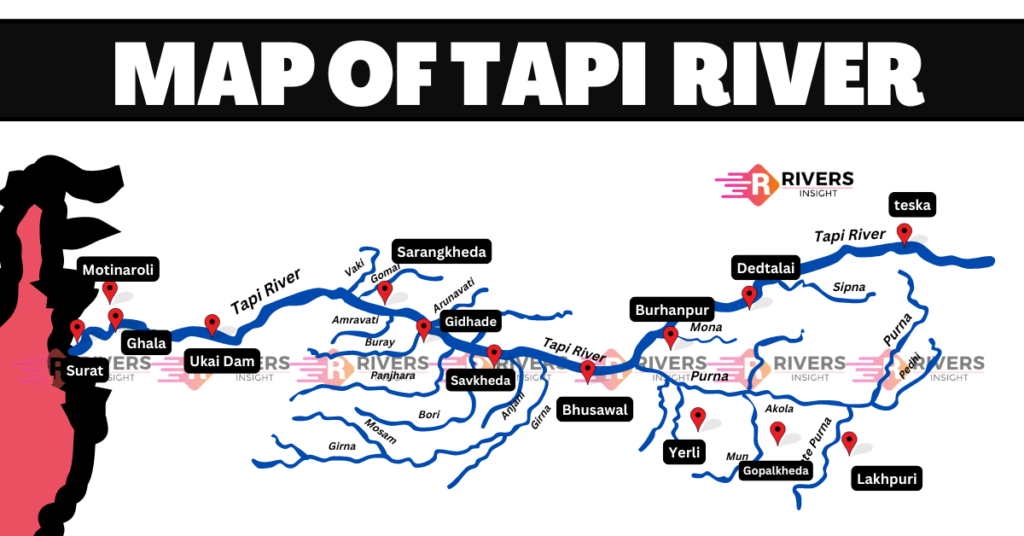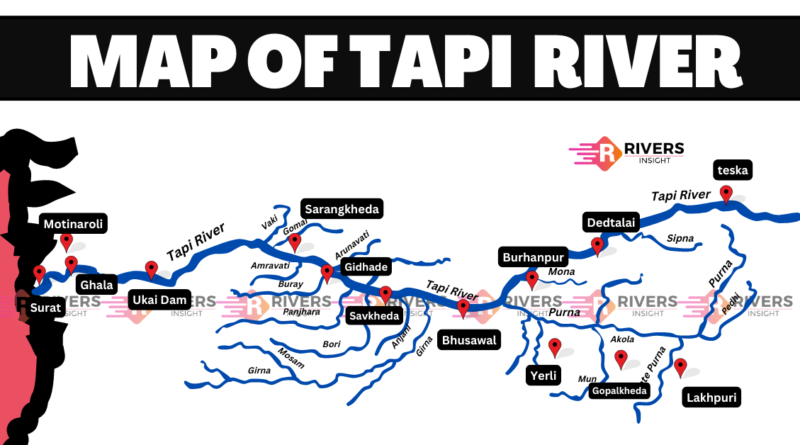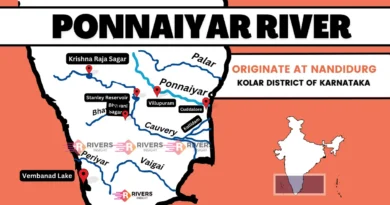Tapi River: Map and Course with Tributaries
The Tapi River also known as the Tapti River is a significant perennial river in western India flowing through the states of Maharashtra, Gujarat, and Madhya Pradesh. Furthermore, it is considered the Narmada’s “twin” or “handmaid” because of its proximity and similar characteristics. Specifically, it flows south of the Narmada River, making it a significant part of peninsular India’s geography.
This article provides an overview of the Tapi River, covering its characteristics and significance. It includes details on the river’s origin, length, tributaries, geographical features, and its position on India’s map.
Table of Contents
Geographical Features of Tapi River
The Tapi River is the second-largest west-flowing river of peninsular India, extending 724km in length as it flows westwards before ending in the Arabian Sea, passing through the states of Maharashtra, Gujarat, and Madhya Pradesh. Moreover, it is one of the three significant rivers, along with Narmada, Mahi, and Tapti, that flow from east to west in peninsular India.
Origin and Course
The Tapi River originates from the Multai plateau in the Satpura Range, located in the Betul district of Madhya Pradesh, India. It rises at an elevation of about 752 meters above sea level.
In Madhya Pradesh, the river flows through the Satpura Range, where it’s joined by tributaries like the Bhawar, Bichhan, and Sur. Then, it enters Maharashtra, flowing through:
- Amravati
- Akola
- Buldhana
- Washim
- Jalgaon
- Dhule
- Nandurbar
- Malegaon
- Nashik
The Tapi River then enters Gujarat, flowing through:
- Surat
- Navsari
Here, it’s joined by the Mindhola and Kim rivers. Finally, the river empties into the Arabian Sea through a wide estuary near Surat in Gujarat.
Map of Tapi River

Drainage Basin
The Tapi River drainage basin is a significant geographical feature in India, covering an area of approximately 65,145 square kilometers, which is nearly two percent of the total area of India. Almost 80% of the basin lies in Maharashtra, with the remaining areas spread across Madhya Pradesh and Gujarat.
- Maharashtra (51,504 km²)
- Madhya Pradesh (9,804 km²)
- Gujarat (3,837 km²)
The basin is located on the Deccan plateau and is limited by:
- North: Satpura range and Vindhyas
- East: Mahadev hills and Maikala range
- South: Ajanta Range and Satmala hills, and Satpuras
- West: Arabian Sea
Tributaries of the Tapti River
The Tapti River is fed by several major tributaries on both its banks. Here’s a simple overview of these tributaries:
Right Bank Tributaries
On the right bank, the tributaries come from the Satpura Ranges. They include:
- Vaki
- Aner
- Arunawati
- Gomai
Left Bank Tributaries
In contrast, the left bank has more tributaries. These tributaries originate from different regions like Gawilgarh Hills, Ajanta Hills, and some other places of western ghats:
- Nesu
- Amravati
- Buray
- Panjhara
- Bori
- Girna
- Waghur
- Purna
- Mona
- Sipna
Important projects in Tapi Basin
- Ukai Dam in Gujarat
- Girna Dam in Maharashtra
- Kakrapar Dam in Gujarat
- Hatnur Dam in Maharashtra
- Gosikhurd Irrigation Project in Maharashtra
- Sarangkheda Project in Maharashtra
- Lower Tapi Irrigation Project in Gujarat
- Bhusawal Thermal Power Station near Maharashtra’s Tapi River
Let’s wrap up our look at the Tapi River. We discussed its 724-kilometer course from the Satpura Range to the Gulf of Khambhat, along with its tributaries and their sources. We also covered key projects related to the river.
What are your thoughts? Do you have any suggestions or feedback? Your insights are really valuable in helping us improve our content!




